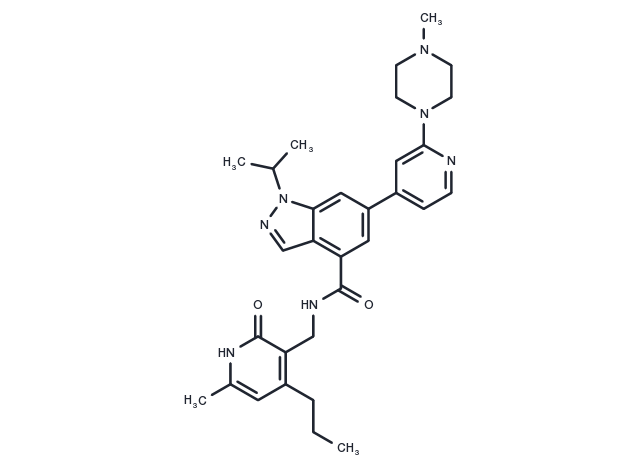keep away from direct sunlight
Powder: -20°C for 3 years | In solvent: -80°C for 1 year

GSK343, a specific and effective EZH2 inhibitor (IC50=4 nM), exhibits 60 fold specificity activity against EZH1, and <1000 fold specificity activity against other histone methyltransferases.

| Pack Size | Availability | Price/USD | Quantity |
|---|---|---|---|
| 5 mg | In stock | $ 54.00 | |
| 10 mg | In stock | $ 87.00 | |
| 25 mg | In stock | $ 181.00 | |
| 50 mg | In stock | $ 297.00 | |
| 100 mg | In stock | $ 538.00 | |
| 1 mL * 10 mM (in DMSO) | In stock | $ 65.00 |





| Description | GSK343, a specific and effective EZH2 inhibitor (IC50=4 nM), exhibits 60 fold specificity activity against EZH1, and >1000 fold specificity activity against other histone methyltransferases. |
| Targets&IC50 | EZH2:4 nM |
| In vivo | Mice treated with GSK343 (5 mg/kg) displayed significantly inhibited tumor growth compared to the control group. The average volume and weight of tumors in the GSK343-treated group were notably decreased. This reduction in tumor growth was evident as early as 20 days post-implantation and continued throughout the study. Furthermore, in the GSK343-treated animals within the xenograft model, there was a substantial increase in the levels of E-cadherin mRNA, alongside a significant decrease in vimentin mRNA levels, compared to the control group[3]. |
| Kinase Assay | In vitro biochemical assays against histone methyltransferases: Activity against EZH2 is assessed using 5 member PRC2 complex (Flag-EZH2, EED, SUZ12, AEBP2, RbAp48). The assay protocol may be summarized as follows: 10 mM stocks of compounds are prepared from solid in 100% DMSO. An 11 point serial dilution master plate is prepared in 384 well format (1:3 dilution, columns 6 and 18 were equal volume DMSO controls) and dispensed to assay ready plates using acoustic dispensing technology to create a 100 nL stamp of compound and DMSO controls. The assay additions consisted of equal volume additions of 10 nM EZH2 and the substrate solution (5 μg/mL HeLa nucleosomes and 0.25 μM [3H]-SAM) dispensed into assay plates using a multi-drop combi dispense. Reaction plates are incubated for 1 hr and quenched with an equal volume addition of 0.5 mg/mL PS-PEI Imaging Beads (RPNQ0098) containing 0.1 mM unlabeled SAM. The plates are sealed, dark adapted for 30 minutes, and a 5 minute endpoint luminescence image is acquired using a Viewlux imager. Plate statistics such as Z' and signal to background as well as dose response curves are analyzed using Activity BaseXE. The in vitro biochemical activity of EZH1 is assessed as part of a 5 member PRC2 complex using a 384 well SPA assay identical to EZH2. Buffer components, reagent dispensing, compound plate preparation, quench conditions and data analysis are identical for EZH1 and EZH2 with final assay concentrations of 20 nM EZH1, 5 μM/mL HeLa nucleosomes and 0.25 μM [3H]-SAM. Further data analysis, pIC50 pivots and visualizations are enabled by TIBCO Spotfire. Compounds are profiled at Reaction Biology Corp. (Malvern, PA) to assess inhibition in their panel of histone methyltransferase assays. Methyltransferase activity is assessed using HotSpot technology, a miniaturized radioisotope-based filter binding assay.Inhibitors are dissolved in dimethyl sulfoxide (DMSO) and tested at concentrations up to 100 uM with a final DMSO concentration of 2%. Buffer containing the methyltrasferase at the listed concentration and its preferred substrate as shown in the accompanying table is preincubated with compound for 10 min. Reactions are initiated by the addition of 1 uM S-adenosyl-L-[methyl-3H]methionine (SAM), allowed to incubate for 60 min at 30C followed by transfer to P81 filter-paper and PBS wash before detection. |
| Cell Research | To account for varying doubling rates among cancer cell lines, the optimal cell seeding is determined empirically for all cell lines by examining their growth in a 384-well plate over 6 days with a wide range of seeding densities. Cells are then plated at the optimal seeding density and allowed to adhere overnight. Cells are treated in duplicate with a 20-point 2-fold dilution series of compound or 0.147% DMSO (vehicle control) and incubated for 6 days at 37C in 5% CO2. Cells are then lysed with 25 μl CellTiter-Glo per well and chemiluminescence is quantified with a TECAN Safire2 microplate reader. In addition, an untreated plate of cells is harvested at the time of compound addition (T0) to quantify the starting number of cells. CTG values after 6 days of treatment were expressed as a percent of the T0 value and plotted against compound concentration. Data are fit with a 4-parameter equation to generate a concentration response curve and the concentration of compound required to inhibit 50% of growth (gIC50) is determined(Only for Reference) |
| Molecular Weight | 541.69 |
| Formula | C31H39N7O2 |
| CAS No. | 1346704-33-3 |
keep away from direct sunlight
Powder: -20°C for 3 years | In solvent: -80°C for 1 year
DMSO: 10.8 mg/mL (20 mM), Heating is recommended.
You can also refer to dose conversion for different animals. More
bottom
Please see Inhibitor Handling Instructions for more frequently ask questions. Topics include: how to prepare stock solutions, how to store products, and cautions on cell-based assays & animal experiments, etc.
GSK343 1346704-33-3 Autophagy Chromatin/Epigenetic Histone Methyltransferase GSK 343 GSK-343 Inhibitor inhibit inhibitor
